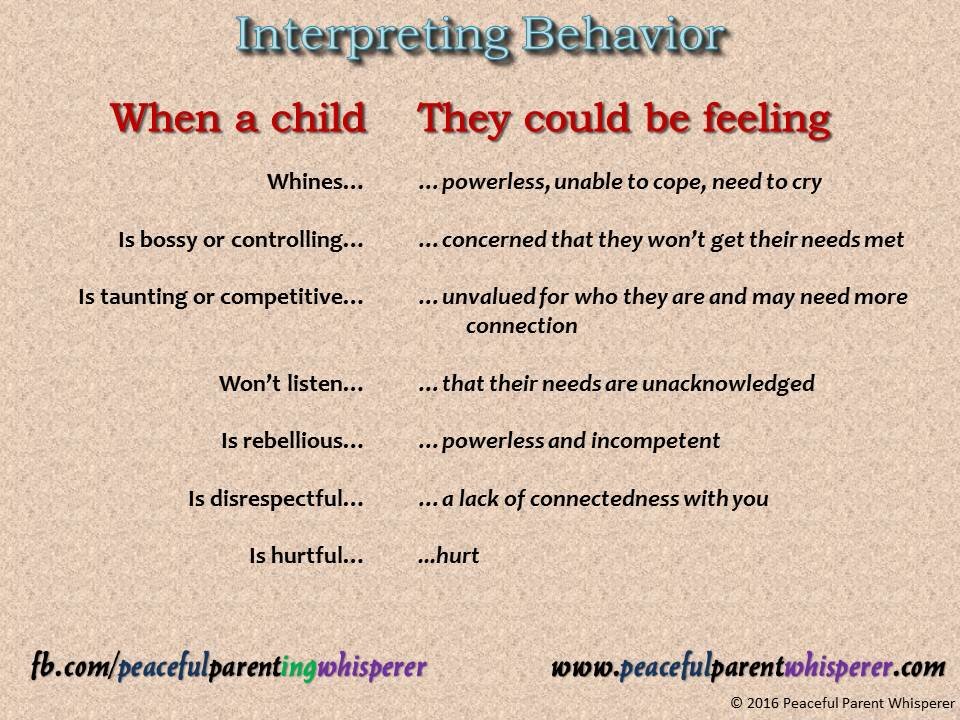The Art of Interpreting Children's Behavior
/Let's talk a moment about manipulation. I get a lot of questions from parents, and they often tell me that they feel their young child is manipulating them, and they want to know how to handle that. These parents tell me they feel kind of like a patsy and like their young child is effective at using clever emotional ploys to win power struggles.
The word "manipulate" is a loaded word. In fact, all communication and behavior (which is communication) could be seen as manipulation...a way we humans have of communicating an unmet need so we can get it met. Facial expressions...even smiles...could be seen as a form of manipulation. Flowers manipulate bees to distribute their pollen for them by offering bees something sweet and nutritious.
Young children are not up to meeting their needs on their own (which is why they get parents in the first place), so they need to figure out early on how to get their help-me message to the all-important person in their life. Cooing, rooting, babbling, smiling, mild fussing, crying, screaming...these are all BEHAVIORS to COMMUNICATE a need.
These behaviors are designed to push a "button" in us to get us to do *something*. Put another way, the behaviors are designed to manipulate us to act. Just like when I stand on the street and flag down a vacant taxi, I am, in a sense, manipulating them to stop for me.
We adults opt for mainly verbal communication, but kids are not so good at communicating their needs verbally (in fact, they aren't even that good at identifying and UNDERSTANDING their own needs), so they act them out using the language of their behavior, and their behavior is designed to irk us enough that we'll act...kind of like a smoke alarm does. :-)
As I said earlier, though, the word "manipulate" comes with some baggage that may create some unfortunate feelings. When you believe your child is manipulating you, you could just try changing the word "manipulating" to "communicating with," and you'll be much closer to the truth. Not only that, though; you will make yourself more available to solve whatever problems your child needs your expert help with because you're less likely to feel guarded and, well, manipulated. :-)
Sadly, the vast majority of us have taken a sip or two of the "Kool-Aid" that has us buying into unflattering judgments about children and their behaviors. Show a picture of a sobbing little child in a supermarket to any crowd of adults, and I'll wager that most of them will have some very lamentable and unkind things to say about that child, including spoiled, ungrateful, bratty, needs a whooping... you know what I'm talking about.
These are judgments and they're simply not true. The problem is that beliefs about children do us and our kids a great disservice, because they're in the air and the water...we've all heard them, and unless we consciously and mindfully reject them, there is often a part of us that believes these malicious untruths. That could cause us to shut down and become less available to the child, who really needs us and our compassion.
Children need us to see the best in them—not the worst—so that we can be helpful to them.
So, the first step in helping children do better is getting rid of our own unhelpful thinking. Instead, we can intentionally get curious about what's really going on for our kids that could be making it difficult for them to behave well in that situation.
It's hard when you're feeling triggered by your kids' behavior, to think of what to do! It's TOTALLY understandable to be reactive rather than responsive. Intentional breathing (for 30-90 seconds) is a great way to press the pause button so that we can shift gears and get intentional and responsive rather than reactive.
I love the L.O.V.E. acronym:
Listen
Observe
Validate
Empathize
One of the MOST challenging things we do as parents and loved ones in all our closest relationships is to focus on how the other person is feeling...rather than how their behavior is making us feel.
My go-to for shifting my own thinking at times like these is to ask myself to fill in the blanks:
"When my child is ______ing, that tells me they may be feeling _____."
This exercise helps me look past the button-pushing behavior to see if I can determine a possible underlying need.
This chart, while not comprehensive by any stretch, may help get you on the right track for interpreting behavior. Feel free to print this out for yourself.
Be well and be kind,
Marji


